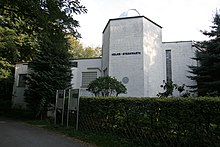Darmstadt public observatory
The Volkssternwarte Darmstadt is an observatory operated by a non-profit association . It is located on Ludwigshöhe in the south of Darmstadt , one of the highest peaks in the city. Its geographical location is 8.663 ° east longitude and 49.844 ° north latitude , 246 m above sea level. NN
history
In 1969 the amateur astronomical association Volkssternwarte Darmstadt eV was founded. The aim was to arouse and promote the population's interest in astronomy and space travel . In 1981 the observatory on Ludwigshöhe was completed. Most of the work had been carried out by members of the association. A number of telescopes are available under a 3 m dome and on a large platform with a roll-up roof . Below are exhibition and lecture rooms as well as an extensive library with astronomical literature.
There are several working groups within the association. a. deal with the observation of the sun , moon , planets , deep-sky objects and astrophotography . A regular online magazine, the "Mitteilungen der Volkssternwarte Darmstadt", reports on astronomical topics and current events.
Instruments
A number of telescopes are used to observe the sky :
Under the dome there is a telescope in a folding construction with a 20 cm aperture and 4 m focal length . The telescope, created in 1964 , is the largest instrument designed by the engineer and telescope designer Günter Nemec. With this type of telescope, the light collected by the objective lens is deflected by means of a mirror, which results in a shorter construction. The telescope is particularly suitable for observing the moon and planets due to the large aperture ratio of 1/20.
A “ protuberance refractor ” with a 12.5 cm aperture and a focal length of 1.3 m is used to observe the sun in red light . The device was also designed by Günter Nemec - the beam path is also folded here. The sun is darkened , like with a protuberance , by means of a conical screen . The protuberances at the edge of the sun can be observed by means of the H-alpha filter, which only lets through the light of the ionized hydrogen .
The deep sky observation is carried out by means of a Newtonian telescope with a 36 cm main mirror and a focal length of 1.6 m.
Further instruments are two Schmidt-Cassegrain telescopes with 25.4 and 20 cm openings. A refractor from Reinfelder & Hertel from 1899 with 13.5 cm aperture and 2.5 m focal length is only used as an exhibit.
Earthquake station
One of eight seismic stations of the Hessian Earthquake Service (HED) at the Hessian State Office for Environment and Geology (HLUG) is integrated in the Darmstadt public observatory; Since 2003, the station has been using a pot-sized seismometer (3-component seismometer type Mark L4), which is embedded in the ground outside the observatory, to monitor seismic activity, especially in the Upper Rhine Rift, from around magnitude 1. The station also detects more distant, stronger earthquakes to worldwide. The recorded data is stored within the observatory and can therefore be available for retrieval with a capacity of more than two months.
Individual evidence
- ^ Association magazine of the Darmstadt public observatory
- ↑ HLUG: Hessian earthquake survey here Ludwigshöhe
Web links
Coordinates: 49 ° 50 ′ 33 " N , 8 ° 39 ′ 42" E
